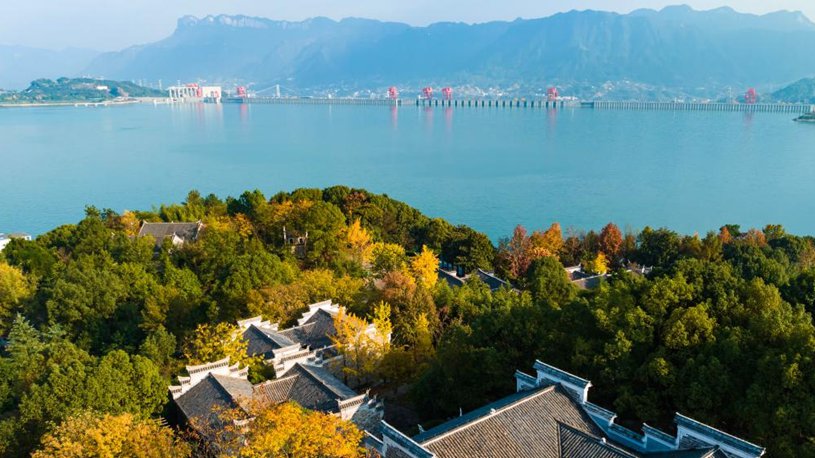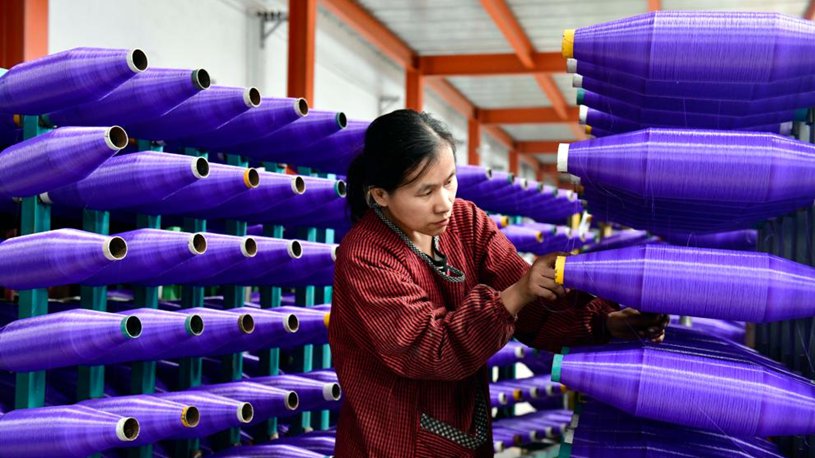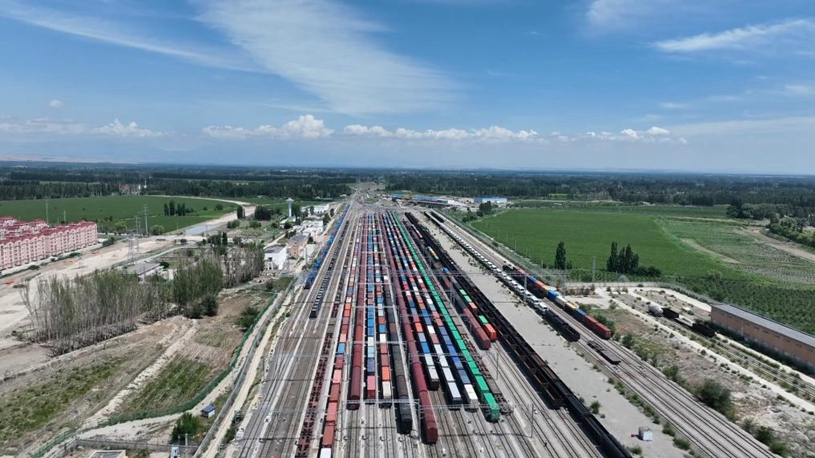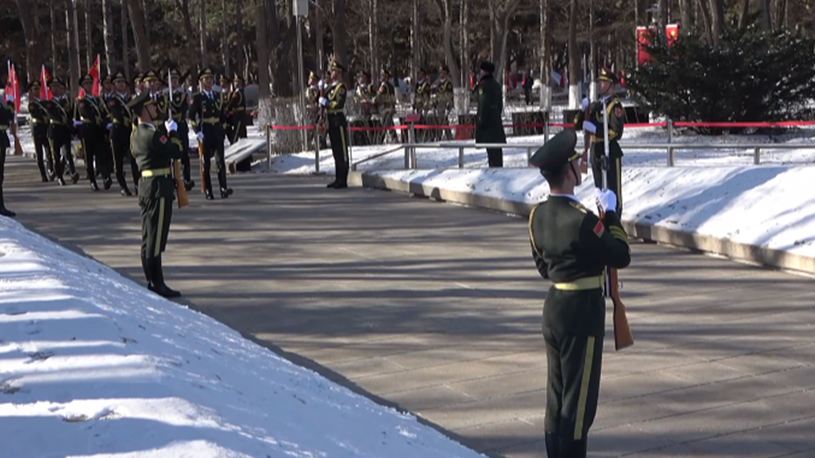* Xinjiang took a historic leap recently with the inauguration of a pilot free trade zone (FTZ), China's 22nd pilot FTZ and the first-ever in the country's northwestern border regions.
* Xinjiang has been making concrete efforts to improve the efficiency of customs clearance and upgrading transportation infrastructure to bolster growth.
* China's youngest pilot FTZ is also expected to support the core area development of the Belt and Road Initiative (BRI) and play a significant role in building a "golden channel" between Asia and Europe as well as a bridgehead for China's westward opening up.
URUMQI, Nov. 25 (Xinhua) -- Xinjiang, a provincial-level region in northwest China with the largest number of land ports in the country, is gaining steam in pursuit of economic growth as its land ports register busier trade and handle more travelers in a drive to expand China's opening up.
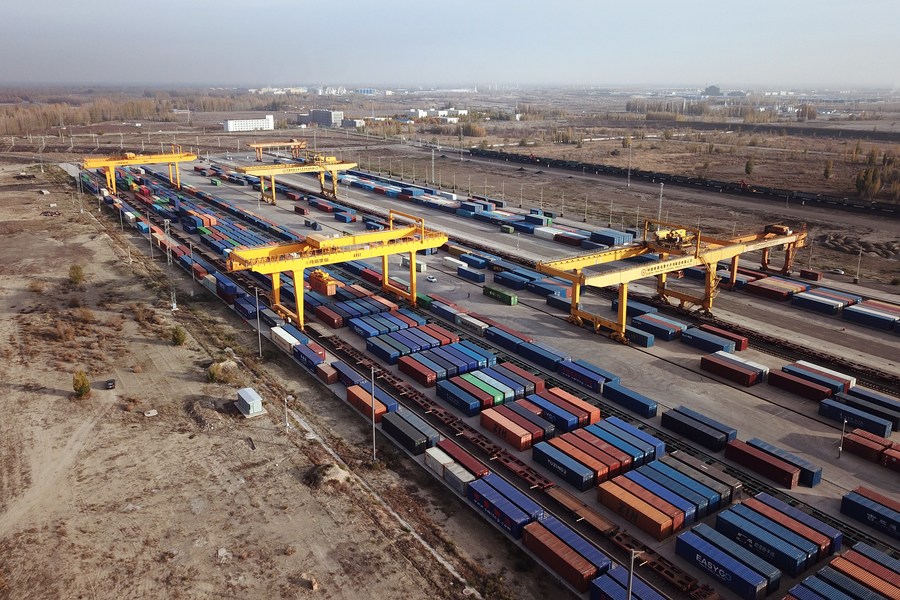
This aerial photo taken on Nov. 8, 2023 shows a view of the Horgos Railway Port in Horgos, northwest China's Xinjiang Uygur Autonomous Region. (Xinhua/Li Xin)
Horgos, Alashankou, Khunjerab, Torugart, Irkeshtam -- these important portals of the Silk Road Economic Belt help strengthen economic and trade exchanges between China and neighboring countries and beyond. With the recent inauguration of the Xinjiang Pilot Free Trade Zone, these ports are poised to play an even bigger role in China's westward opening up.
VIBRANT PORTS IN WESTWARD OPENING UP
Up on the Pamirs in south Xinjiang where the altitude averages about 4,700 meters sits the Khunjerab Pass, a land port on the China-Pakistan border and an important gateway to South Asia and Europe.
Pakistani merchant Hussain Basit waited in line for customs and immigration checks to go through the port. He has been providing Pakistani consumers with access to much sought-after Chinese goods like clothes, bed linen and home appliances for many years.
"I have crossed the border almost every week for Chinese goods this year, more frequent than ever because it is getting increasingly convenient," said Basit while shouldering stuffed luggage.
The ease with which Basit crosses the border is widely shared among businessmen and travelers. Since the resumption of passenger customs clearance on April 3, 2023, the Khunjerab Pass has recorded over 40,000 inbound and outbound passengers.
Xinjiang has been making concrete efforts to improve the efficiency of customs clearance. On August 14 this year, Horgos became the first road port in Xinjiang to trial 24/7 passage for traded goods. Torugart port in south Xinjiang this month adopted these same hours.
"Initially, I had to wait and stay in Horgos for 10 days to load goods and clear customs. Now it only takes me two to three days," said Kazakh truck driver Salamat Abdilda, adding that his income has increased as a result.
Horgos Customs data shows that in the first three quarters this year, the highway port had recorded about 1.36 million tonnes in terms of its import and export volume of freight, up 115.3 percent year on year.
Other major ports have also seen a surge in trade. According to Urumqi Customs, the total value of imports and exports in Xinjiang in the first 10 months of 2023 had reached 287.33 billion yuan (about 39.67 billion U.S. dollars), a year-on-year increase of 48.9 percent.
Xinjiang is also upgrading transportation infrastructure to bolster growth. The railway station at Alashankou, also known as Alataw Pass, a crucial hub connecting China with Central Asia and Europe, is under construction to increase its capacity.
With better infrastructure and customs services, Alashankou has attracted many investment enterprises. This year alone, over 130 companies have been established in the Alashankou integrated free trade zone.
More measures to underpin the role of land ports in Xinjiang's development are in the pipeline. Hao Weiming, head of Urumqi Customs, said customs clearance of agricultural products will be fast-tracked through "green channels" at border ports, while cross-border trade of minerals and automobiles will also be made easier.
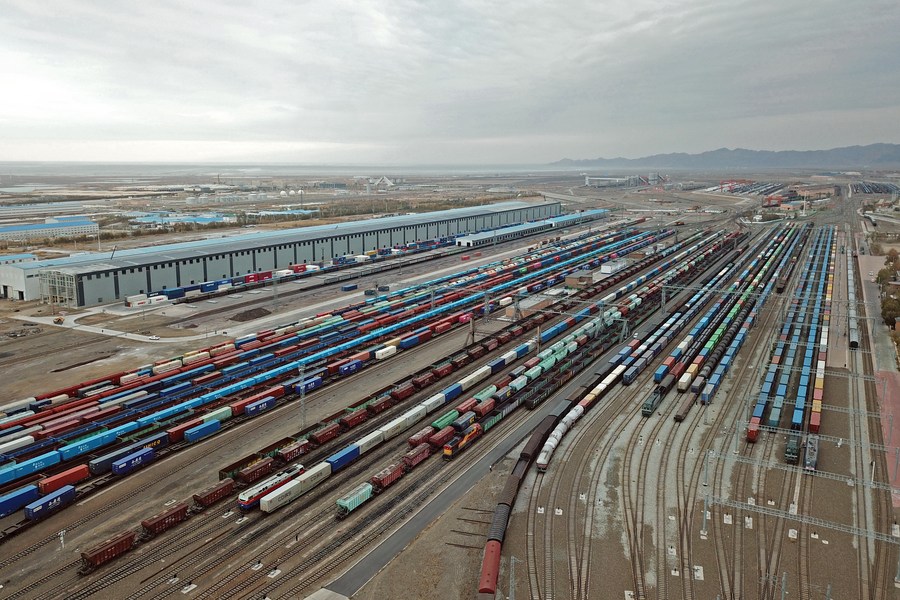
This aerial photo taken on Nov. 4, 2023 shows cargo trains waiting for departure at the railway station at Alashankou, in northwest China's Xinjiang Uygur Autonomous Region. (Xinhua/Li Xin)
FRESH OPPORTUNITIES ABOUND
Xinjiang took a historic leap recently with the inauguration of a pilot free trade zone (FTZ), China's 22nd pilot FTZ and the first-ever in the country's northwestern border regions.
Covering approximately 180 square km, the pilot FTZ comprises the iconic areas of Kashgar prefecture, Urumqi and Horgos, and is expected to contribute greatly to Xinjiang's integration into both domestic and international markets and boost local socioeconomic development.
China's youngest pilot FTZ is also expected to support the core area development of the Belt and Road Initiative (BRI) and play a significant role in building a "golden channel" between Asia and Europe as well as a bridgehead for China's westward opening up, according to a general plan released by the State Council.
Leveraging their edges in international trade and logistics, the three iconic areas will further tap into their comparative strengths and jointly serve local, national and broader regional development.
Urumqi, for instance, will focus on developing global trade, modern logistics, advanced manufacturing, textiles and clothes as well as new emerging industries like biopharmaceuticals, new energy and new materials and is also set to become an important platform for exchanges and cooperation with neighboring countries, including those in Central Asia.
Kashgar will expand and strengthen an export-oriented economy, and develop labor-intensive industries such as deep processing of agricultural and sideline products, textile and clothing manufacturing, and electronic product assembly.
Horgos is poised to leverage its role as an international cooperation center to develop modern service industries such as cross-border logistics, travel and financial services, and make itself a model of cross-border trade and investment cooperation, according to the general plan.

A truck drives at the Irkeshtam port in northwest China's Xinjiang Uygur Autonomous Region, Nov. 7, 2023. (Xinhua/Ding Lei)
Zaydulla Tursun, a cross-border e-commerce businessman, has made a fortune thanks to the Urumqi Comprehensive Bonded Zone.
"After consumers order bonded goods online, customs clearance is carried out in real time, and three to five minutes later, the goods leave the Urumqi Comprehensive Bonded Zone and are efficiently connected to express delivery," said Zaydulla, adding the goods can be delivered within the city in 24 hours, and throughout Xinjiang in three days.
"The inauguration of the pilot FTZ is set to more fully unleash Xinjiang's unique locational strength, and actively serve and integrate the region into China's new development paradigm," said Zhuang Rui, executive dean of the Institute of International Economy at the University of International Business and Economics.
Analysts also believe that the milestone inauguration will turn Xinjiang into a magnet for domestic and overseas resources as well as a land of promise with an excellent business environment, convenient access for investment and trade, an agglomeration of advantageous industries, and achieve an outstanding spillover effect.
"To the south, it will connect the supply chain of Xinjiang to eastern coastal areas, and prompt more high-tech industry chains in the eastern area to relocate to Xinjiang," said Tian Yun, a veteran macroeconomist and former vice director of the Beijing Economic Operation Association. "To the north, it will link Xinjiang with Central Asia and West Asia, unleashing prodigious regional economic benefits." ■
(Video reporters: Zhou Shengbin, Ding Lei, Aman, Guan Qiaoqiao, Liu Hongxia; video editors: Zhou Saang, Yin Le, Zhang Nan, Liu Ruoshi)



